Craters - 10 Days...
Plato:
Date: October 15, 2002
Telescope: 31" Warren Rupp Observatory
Eyepiece: 32mm, 2" Televue
Time: (no specific time given. reports indicate early evening.)
Comments: Slipping a CD into the small stereo, I'm not wanting the classics tonight... It's time to rock the dome! Head filled with "Tantric" at a volume loud enough to discourage wandering wildlife, it's time to shut off the lights and go for a ride. Our destination is only about 239,000 miles away... And I want to take you there.
(One brief glance and Whoa! OK... Back down for the filter... ;)
Plato was there in all its' magnificence. With all the power I can put on it in the backyard, it cannot compare with what this does. The interior craterlets that we have sought after for so long are strikingly clear. There are five. Two of them are side by side, another breaks away not far from them. The remaining two? One is about a fourth of the distance of the diameter away from the edge, and the fifth is at the very edge of the wall shadow. And the walls and shadows! They don't even look real... The walls look like cut slabs in places, and the shadows they cast are not soft at all. They are razor sharp, and on the smooth floor of Plato, they stand out in stark relief.
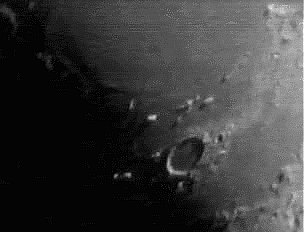
Crater Plato as seen through a 4.5 Celestron telescope. Mons Piton and Pico as well as the Teneriffe Mountains also show in this frame.
Archimedes:
Date: March 21, 2002
Telescope: 4.5 Celestron
Eyepieces: 25mm Celestron, 10mm Celestron
Time: (no specific time listed. reports indicate late p.m.)
Comments: Archimedes held court... with tiny Kirch in attendance. The great rille bissected by Piazzi Smyth looking like a bulging vein on the surface. How I have missed the Moon! And in that notch, right there... you see? That is where the Apollo 15 landed... A cold place, but so very, very beautiful.
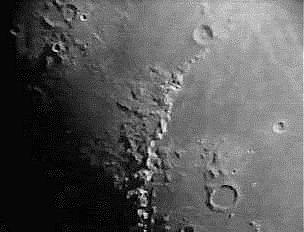
Archimedes is the shallow ring toward the bottom right, while Eratosthenes appears at the tip of of the Apennine Mountains.
Ptolmaeus:
Date: January 21, 2001
Telescope: 4.5 Celestron
Eyepieces: 25mm Celestron, 10mm Celestron
Time: (no specific time listed. reports indicate late p.m.)
Comments: There was a whole wide Moon to look at tonight... Fantastic details on the crater chain that runs from Walter to Ptolemaeus... and where did I want to go? Archimedes. Don't understand why... There were plenty of things to look at, like the deep scar of the Alpine Valley, or the punctuation of Aristuillus and Autolycus. I just got lost in the mountains is all. Feeling the need, and I don't understand it. So just latch on the those fantastic peaks of the Apennine Mountains, and visit the Apollo 15 landing site. Just.. forget.
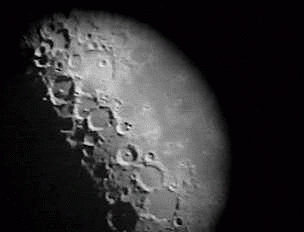
From bottom toward top: Ptlolemaeus, Alphonsus and Arzachel
Alphonsus and Arzachel:
Date: December 31, 2003
Telescope: 12.5 Meade
Eyepieces: 26mm Meade, 9mm Meade
Time: (no specific time listed. reports indicate late p.m.)
Comments: I smile and go on to the Moon. Plato catches my eye, and as I watch I remember all the fun I once had trying to draw the "craterlets" out. The Appeninne Mountains are just incredible, but the features that keep me in place tonight are Ptlomaeus, Alphonsus and Arzachel. It is blinding in the dob, but I've no real wish to fetch a filter. I came to this place on the lunar surface tonight to remember Ranger 7. Yep. It crashed... But sent back some of the most incredible photos before it bit the lunar dust! I watch for as long as I can stand the light... It is a bit windy and cold. I think perhaps it is time for me to find that cup of coffee and go warm up for a bit.
Walter:
Date: January 21, 2002
Telescope: 4.5 Celestron
Eyepieces: 25mm Celestron, 10mm Celestron
Time: (no specific time listed. reports indicate late p.m.)
Comments: There was a whole wide Moon to look at tonight... Fantastic details on the crater chain that runs from Walter to Ptolemaeus..
Maginus:
February 11, 2003
Time: 7:15-8:00 pm EST
Seeing: 4 6/10
Binoculars: 5X30 Tasco
Scope: 4.5 Celestron
Eyepiece: 26mm Meade
Comments: Through binoculars, Maginus is well off to the east terminator on the southern limb of the Moon. While the bright ring of the edges are easily captured, the floor itself does not look entirely dark... It appears "raised" somehow - With a brightening toward the eastern portion.
In keeping with this exercise, I have to smack my hands to keep the scope at low power. Maginus now displays a peppered crater edge that makes me smile! Three perfect craterlets form a triangle on the northwestern edge. One small craterlet lies just to the north of that curious brightening, while the southeast is broken up into a series of bright points.
Sure I can't power up on it??

Predominate craters in this photo are from center bottom - Tycho, center - Maginus, upper right - Clavius.
Tycho:
Date: November 8, 2003
Telesccope: 4.5 Orion
Eyepeice: 25mm Orion
Time: (no specific time given. during total lunar eclipse. approximate time 8:00 p.m.)
Comments: Tycho explodes into a golden cauldron, its' bright rays transformed into splash marks of molten lava. I hear myself calling out to alert the others to look... It is incredible. I am amazed at the stellar field, there are so many grazers around the orb of the Moon, I am surprised that there is not an occultation. Truly it doesn't get more beautiful than this!! I look down at my watch and realize we are in totality...
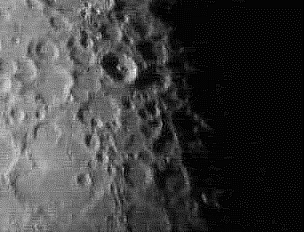
Tycho appears with it surrounding craters and central peak just slightly above center.
Clavius:
Date: December 2, 2003
Telescope: 4.5 Celestron
Eyepieces: 25mm Celestron, 10mm Celestron
Time: (no specific time given. reports indicate late p.m.)
Comments: Oddly enough, I was also captured by a major feature to the south as well. Who amoung us doesn't love Clavius?? I know it's not exactly an incredible shot, but things were trying to frost up by the time I got finished heavy breathing over Eratosthenes. But it doesn't matter. The details inside of Magninus, Clavius and the shallow Gruemberger really rocked!
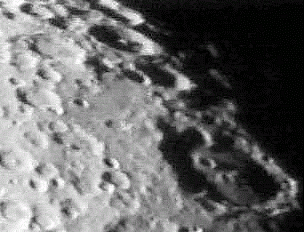
Eratosthenes:
Date: December 2, 2003
Telescope: 4.5 Celestron
Eyepieces: 25mm Celestron, 10mm Celestron
Time: (no specific time given. reports indicate late p.m.)
Comments: I didn't care much for the way the "Straight Wall" was lighted tonight... Too over-exposed. Plato was simply magnificent and the chain of the Appennine Mountains looked like they were capped in snow. Oddly enough, I'm not big on the major features, but for some reason Eratosthenes really caught my attention... Maybe it was the way the mountain ranges thinned down, or perhaps it was the Sinus Aestuum... But whatever it was? It kept me there.

Longomontanus:
Date: November 14, 2002
Telescope: 150mm Intes
Eyepiece: 17mm Sirius Plossl
Time: (no specific time given. reports indicate late p.m.)
Comments: Realizing the hours are going to be long over the next few days, I amost hate to go in because I know that rain is in the forecast. But before I leave I do at least enjoy casting the fine eye of the Intes over a few that I am well acquainted with. Longomontanus, Wilhelm, Hainzel and Mee.... Just good to see them again. As well as Scheiner and Klaproth...
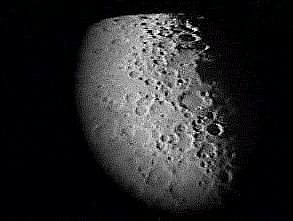
Although there are many wonderful craters in this frame, Longomontanus is featured roughly in the center on the terminator.
Copernicus:
February 11, 2003
Time: 7:15-8:00 pm EST
Seeing: 4 6/10
Binoculars: 5X30 Tasco
Scope: 4.5 Celestron
Eyepiece: 26mm Meade
9mm Meade
Comments: It would be impossible NOT to see Copernicus in binoculars. As the single most outstanding feature to this piece of equipment, it appears as a perfect ring with a bright floor and a dazzling line of rays extending from it.
To the scope at low power, Copernicus' wall begin to form and the central peak shines. Drop in the magnfication and the walls now become broken and irregular, like a series of mountain chains that simply took on a circular shape. The interior now has more than one peak. The nearby Carpathian Mountains stand out in stark relief, and small crater Gay-Lussac has a conical appearance with a bright ring that makes it appear volcanic.
Perhaps the most interesting thing about Copernicus with any instrument, it the appearance of great age. It wills the eye to it!
October 15, 2002
Telescope: 31" Warren Rupp Observatory
Eyepeice: 32m 2" Televue
Time: (no specific time listed. reports indicate late p.m.)
Comments: And oh, my. Copernicus. There is no way that I could even begin to think about drawing Copernicus. Incredible.... Simply incredible. The interior has two soft looking series of mounds within it, and from these mounds grow mountain peaks. There is a shallow, ditch-like line that creases through there, and all about the smoother areas of the interior surface are scattered what appears to be huge boulders. The exterior walls are a true fantasy land. Eroded, creased... huge! And all throughout them are tiny pepper marks of impact craters the not even the Rukl begins to touch.
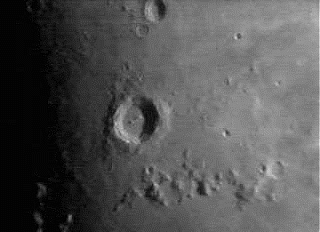
The incomparable Copernicus as seen through the 4.5 Celestron at high power.
Bullialdus:
Date: April 14, 2004
Telescope: 4.5 Orion reflector
Eyepiece: 17mm Sirius Plossl
Seeing: 6/10 ULM: 5.0 Temp: 33
Time: 5:15 a.m.
The last crater I view at power is Bullialdus. Its' A and B craters are easy... As is the central peak area and the depth of its' terraced walls. There is a "puckered" look to the area outside the walls of the crater proper and they extend toward the shallow and broken walls of Lubiniezky. It is an ususual and almost raised looking area... Perhaps once a volcano?
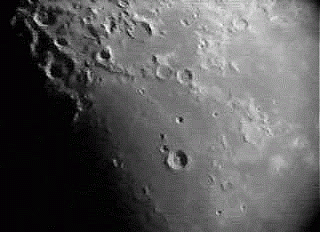
Giant pockmark Bullialdus is featured to the lower center of this frame with accompanying craters.
Aristarchus:
February 13, 2003
Time: 7:00-8:00 pm EST
Seeing: 8/10
Binoculars: 5X30 Tasco
Scope: 4.5 Celestron
Eyepiece: 26mm Meade
Comments: To the binoculars, Aristarchus is a brilliant point of light to the northwest quandrant of the lunar surface. Almost on the terminator with this power, it sits at the edge of Mare Ibrium.
To the scope, even at low power, Aristarchus is highly overlit. Companion crater, Herodotus joins with it cleanly and the Harbinger Mountains stand out in relief.
Take the time to power up on this one, because when it's near the terminator (like it is tonight) it contains the telescopic challenge, Schroeter's Valley.
Gassendi:
February 12, 2003
Time: 7:15-7:45 pm EST
Seeing: 9/10
Binoculars: 5X30 Tasco
Scope: 12.5 Meade
Eyepiece: 26mm Meade
Comments: I'm not real cracked on the image of Gassendi through binoculars. Near the terminator, and at the northern edge of Humorum, the southwest quadrant crater doesn't give anything more than the appearance of a bright, shallow ring.
But it walks and talks in the dob.
Even a low power, Gassendi is an ancient wealth of details. Having multiple interior peaks and small interior craterlets, Gassendi is capable at low power of revealing several interior rima that seem to have a pentagonal pattern to them as they criss-cross the floor. Craters A and B are perfectly visible, as well as P and M. (and a darn sight more alphabet soup letters in the surrounds of the mare!)
Here... It's your turn at the eyepiece!
Date: July 10, 2003
Telescope: 4.5 Celestron
Eyepiece: 12.3mm ED Epic
Time: (no specific time lsited. reports indicate late p.m.)
Gassendi: Comments: Smiling to myself, I set the old Celestron down on the area with the 12.3mm. How wonderful to be able to stand here on Earth and view the Mare Humorum, knowing that it's roughly the size of Arkansas. Gassendi itself is amazing... Perhaps one of the most ancient of craters on the lunar surface. At around 287 miles wide, Baldwin believes that Gassendi was formed by a planetoid that struck the Moon during its' volcanic period. This huge impact shocked the surface so much that it actually left concentric damage that matches Gassendi's concentric edges at an incredible distance of 594 miles! Then along came the lava and filled the floor of Mare Humorum... Even the ancient Vitello, located directly south across Mare Humorum was filled in by this flow.
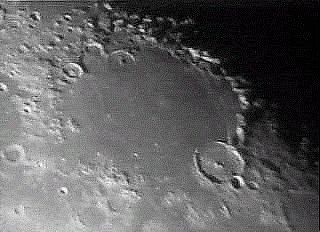
Gassendi on the edge Mare Humorum.
|